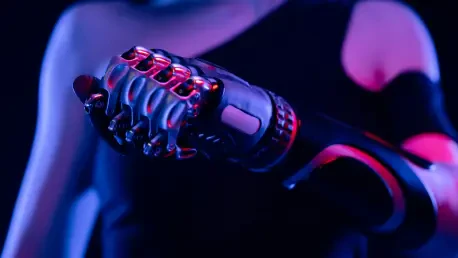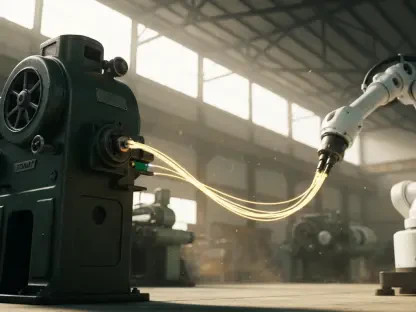In the realm of robotics, the Massachusetts Institute of Technology is at the forefront, pushing boundaries with an innovative system that marries precision with adaptability. Tailored to recreate and compete in table tennis games, this robotic platform embodies years of research and technological advancement in robotics and artificial intelligence. Developed by MIT’s Biomimetic Robotics Laboratory, this sophisticated robotic arm mirrors human-like agility and responsiveness, heralding significant progress in the intersection of robotics and sports. This breakthrough paints a vivid picture of a future where robotic systems are not just mimicking human actions but potentially surpassing them in specific athletic tasks. At the heart of this development lies a complex interaction between dynamic control systems and robotics within a sporting context.
Exploring the Core of MIT’s Robotic Breakthrough
The Robotic Arm’s Adaptive Capacity and Precision
The central innovation crafted by the MIT Biomimetic Robotics Laboratory revolves around a robotic system engineered to exhibit human-like dexterity and precision. Designed to replicate the actions needed in table tennis, this platform brings together cutting-edge hardware and advanced control algorithms to create a revolutionary training partner for enthusiasts and athletes alike. The technology does not just aim to serve as a practice partner but has also shown the potential to compete at high levels, altering the landscape of how we perceive robotic capabilities in sports contexts. By harnessing adaptive software, the robotic arm can dynamically adjust its movement patterns to respond to the unpredictable trajectory of a fast-paced game, making in-the-moment decisions that elevate its performance.
This system utilizes sophisticated sensor arrays and data-rich algorithms to predict and react to the ball’s movement in real-time. The sensors embedded in the arm gather crucial information regarding ball speed and spin, allowing the control algorithms to anticipate the ball’s trajectory. These algorithms then dynamically recalibrate strategies, ensuring that the arm meets the demands of table tennis, a sport renowned for requiring rapid decision-making and precise control. Such complexity in design is fundamental to achieving the fluidity and responsiveness akin to a human player, indicating the profound advancements the MIT team has integrated into the sports equipment domain.
Integration of Software and Hardware
The success of MIT’s robotic arm largely hinges on the seamless integration between software and hardware components. This synergy is cultivated through a partnership of custom-designed elements and comprehensive computational modeling. The robotic arm itself is equipped with high-torque motors, optimized for low inertia rotor design, enabling the modular components to operate with the exceptional speed and flexibility needed for fast-paced athletic interactions. While hardware developments provide the necessary physical movement and strength, the software enables predictive and adaptive calculations, both essential in a sport such as table tennis, where the ball’s behavior can change instantaneously.
MIT’s approach emphasizes modularity, allowing for adjustments tailored to specific needs or conditions. As trends move toward customization in robotics design, this dual focus on sophisticated hardware and responsive software enhances the lab’s ability to refine its system for optimal performance. For instance, enhanced trajectory prediction software ensures the robotic arm maintains high efficiency even under varying game conditions. This unique amalgam of predictive modeling alongside real-time computational adjustments makes the system not only a breakthrough in robotics design but also a testament to MIT’s forward-thinking approach in overcoming the challenges inherent in dynamic sports interaction.
Unraveling Themes of Robotics in Sports
Pursuing Athletic Parity and Precision
In recent years, robotics has become an integral component in replicating human actions, facilitating advancements in various sports contexts. The endeavor is not solely about mimicking human movements but focuses on achieving precision and potentially surpassing human capabilities in specific tasks. MIT’s team has leveraged this domain by concentrating on table tennis—a sport that uniquely combines agility, speed, and precision—to showcase the latest developments in artificial intelligence and robotics. This focus not only provides a dynamic testbed for innovation but also establishes a platform for future exploration in sports robotics.
With a precision-first approach, MIT’s robotic system demonstrates a unique balance between kinetic and cognitive complexities. The intricate interplay between predictive software and the mechanical performance of the robotic arm has engendered a success rate that runs parallel to human performance in table tennis. Allowing computational algorithms to anticipate ball movement fosters a harmony between reactive and predictive impulses, reflecting broader shifts toward systems that are both adaptive and precise. Viewing this in the context of research and development provides valuable insights into the possibilities that lie ahead when robotics intersects with athletic endeavors, highlighting MIT’s commitment to pushing boundaries in both academic and practical spaces.
Dynamic Control Systems and Their Implications
At the heart of the robotic system is an elaborate control mechanism that integrates predictive modeling with real-time responses. Intellectual advancements in control algorithms allow the robotic arm to predict the path of the table tennis ball while dynamically calibrating its movements to maintain precision and agility. The ability to adjust strategies promptly signifies refined control fostering advancements in robotics. By not relying solely on pre-planned actions, the system reflects the unpredictability associated with dynamic, real-world environments, transforming how robots interact in fast-paced scenarios as evidenced in table tennis matches.
Intertwining predictive capabilities with reactive adjustments epitomizes current trends focused on creating systems that smoothly operate in real-world environments. The MIT team endeavors to uphold this consensus, recognizing its significance in evolving robotic designs. Such advancements in control systems spotlight the importance of human-robot collaboration, providing a roadmap toward robotic systems excelling beyond typical pre-designed movements. Observing this evolution opens doors to discussions on the future of automated systems, particularly when critical thinking and real-world interaction stand paramount.
Consensus Trends and Future Implications
Customization and Modular Design in Robotics
MIT’s table tennis arm emphasizes the significance of customization and modular design, steering the latest trends in robotics development. Its implementation manifests bespoke components tailored for specific applications, departing from generalized approaches to meet particular athletic demands. Technological enhancements such as specialized motors reinforce the control needed for rapid adjustments in sports contexts. The movement toward modularity in design asserts the stance that precision and adaptability are essential, providing sharper insights into evolving robotics research and commercial applications.
Understanding the implications of such design choices showcases broader applications beyond sports. For instance, sectors like search and rescue can benefit from robotics that possess high adaptability, demonstrating the urgent necessity for dynamic interaction within unpredictable environments. MIT’s innovations provide insightful perspectives on custom solutions driving advancement in robotics, framing future discussions on technological trajectories and potential integration within varied industries. As customization becomes increasingly pivotal, it offers distinct opportunities for robotics to excel in niche environments, highlighting MIT’s foresighted application of intelligent systems in expanding fields.
Predictive and Reactive Enhancements in Robotic Systems
The narrative around MIT’s table tennis arm converges towards integrating predictive capabilities with reactive enhancements, forming the major trends shaping robotic systems. This approach mirrors the evolving consensus in robotics toward collaboration between foresight and adaptability, challenged primarily by dynamic, real-time settings. The ability to predict the trajectory of moving balls and align physical movements showcases robot readiness to embrace real-world complexities, underscoring the intersection where robotics meets cognition to derive impactful outcomes.
From the standpoint of performance, seamlessly blending predictive modeling with adaptive reaction highlights the crucial role played by control algorithms in navigating unexpected developments during matches. Deploying computational insights to anticipate variables establishes a foundation for systems thriving in ever-changing environments. As robotics aligns closer with human needs, this blend of foresight paired with adaptability promises profound contributions to advancements in robotic science and applications. Through this lens, MIT demonstrates a robust commitment to deploying solutions that resonate beyond academia, venturing into realms where action and prediction are aligned to fuel innovation.
Synthesizing the Robotic Advancement Narrative
Analyzing Interdisciplinary Development
Exploring the advancements with MIT’s robotic system reveals intricate interdisciplinary collaboration underpinning the table tennis arm’s development. The integration of motion tracking with sophisticated control algorithms elevates the platform’s performance in controlled environments, transcending common limitations associated with robotic systems. A nuanced synergy between perception modules and modeling strategies empowers the robotic arm while fostering high performance in sport-based tasks. Such data-driven decision-making combined with agile mechanical movements offers impactful insights applicable across varied domains beyond table tennis.
This synthesis proposes a forward-thinking narrative that integrates sensor technology with control strategies to achieve scalable, high-precision outcomes. By delving into academic concepts alongside practical implementations, MIT’s laboratory enriches the robotics narrative through cutting-edge advances. This evolution emphasizes the shift toward robots actively engaging in complex real-world activities. Engaging beyond theoretical frameworks leads to promising commercial applications, affirming the laboratory’s profound impact on envisioning robotics as an agent within dynamic human environments.
Emerging Dynamics with Robotic Systems
MIT’s pioneering efforts culminate in an overarching narrative examining emerging dynamics within robotics design. The system amplifies optimized robotic agility merged with precision that transcends traditional robotics paradigms, cultivating potential pathways for innovation. Through steadfast dedication to both theory and practice, MIT’s team forges advancements pivotal to enhancing human-centric interactions with robots. By addressing inherent challenges indicative of simulating human performance, the narrative propels a future envisioning robots as collaborative allies capable of pursuing intricate, athletic activities alongside their human counterparts.
Acknowledging the thematic evolutions around robotics emphasizes the constant progression toward systems embracing dynamic adaptability. MIT’s laboratory actively transforms sports robotics, reflecting broader shifts where robotic systems redefine collaboration possibilities. Such advancements intrigue scientific communities while fostering meaningful discussions around harmonizing robotics with human interaction, paving the way for transformative creations surpassing previously held limitations. Translating theory into actionable outcomes materializes a vision where robotics becomes instrumental in nurturing synergies between cognitive pursuits and athletic challenges, underscoring MIT’s commitment toward exploring uncharted territories in robotic development.
Addressing Findings and Implications
Achieving Precision and Adaptability
MIT’s table tennis robotic arm stands as a testament to achieving high precision and adaptability, marking a critical advancement within robotics development. The ability of the robotic system to integrate novel data inputs in real-time while maintaining precision reflects successful accomplishments of the algorithmic components. Its establishment as a precise, adaptive platform highlights MIT’s role in facilitating breakthroughs within the sporting domain, challenging conventional boundaries associated with human performance and robotic interaction. This endeavor accentuates the seamless fusion between computational interpretation and mechanical finesse that extends far beyond isolated case studies.
Empirical validation underscores the system’s proficiency, surpassing expectations with its recorded success rate in table tennis matches. Such metrics reveal the underlying depth of algorithmic sophistication coupled with mechanical ingenuity elevating the robotic arm’s responses during games. Through strategic maneuvers and rapid algorithmic recalibrations, MIT’s innovations introduce a fresh paradigm of robotics performance intertwined with cognitive precision. The tangible outcomes reinforce applications within broader areas of interest, highlighting potential technological trajectories in sports and beyond.
Distilling Insights Beyond Sports
The potential repercussions of MIT’s innovations extend beyond immediate sports applications, contributing to fields requiring precise dynamic interaction. Examining the mechanical and algorithmic prowess embedded within the table tennis system reveals implications pivotal for sectors like search and rescue, where adaptive precision remains vital. This crossover into diverse domains presents a compelling narrative for deploying robotics as solutions within evolving, unpredictable environments, ensuring efficiency persists regardless of operational uncertainties.
Explorations into the potential real-world impacts affirm the significance of collaborative endeavors between humans and robotic systems, unveiling layers of interaction defined by the infusion of cognitive intelligence within mechanical designs. MIT’s success inspires compelling scenarios where robotics engages fluidly with varied operational demands, cultivating discussions around technology’s role in redefining collaboration across sectors. This embodies the imperative to integrate robotics as an ally in challenging environments while suggesting innovative pathways future advancements may pursue.
Conclusion: Navigating the Future of Robotics in Sports
In summary, MIT’s groundbreaking table tennis robotic arm represents a notable stride in marrying precision with adaptability, reshaping unique intersections where robotics meets athletics. The laboratory’s innovative approach underlies practical advancements poised to redefine initial perceptions of robotic systems as mere mechanical tools, advocating their potential as collaborative agents across diversified applications. The insights gained from MIT’s pursuits indicate promising parallels between robotic evolution and human-centric demands, offering actionable next steps toward ensuing progress.
Acknowledging the transformative impacts realized through precision and adaptability provides avenues to explore robotics within non-traditional spaces, affirming consistency with dynamic challenges beyond isolated contexts. MIT’s dedication to algorithmic fine-tuning paired with mechanical agility sets a persuasive tone encouraging ongoing dialogue in academia and beyond, invigorating communities inspired to embrace the uncharted evolution of robotics as an influential contributor across domains. This reflective journey captures the laboratory’s enduring commitment toward innovating robotics within nuanced environments, empowering future explorations into harmonious convergence between technological possibilities and human ambitions.









